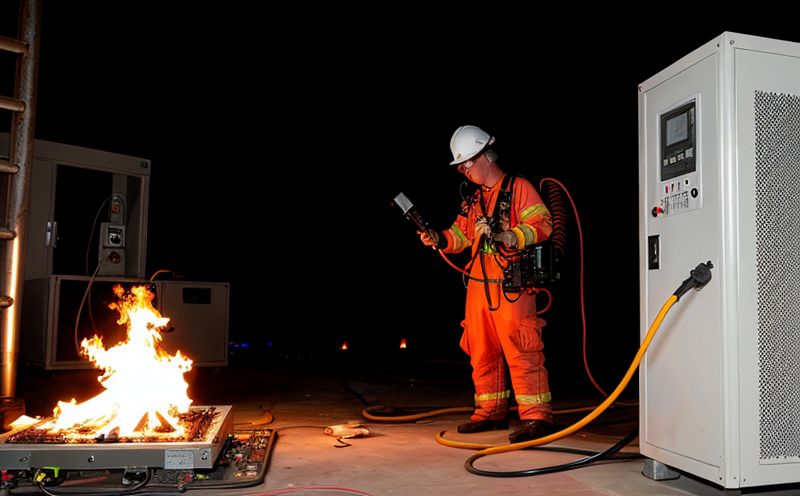IEC 60695-11-10 Fire Hazard Testing of Electrical Equipment – Small Flame Test
The International Electrotechnical Commission (IEC) Standard IEC 60695-11-10 provides a method for assessing the fire hazard potential of electrical and electronic equipment. This particular test, known as the small flame test, is designed to evaluate the behavior of materials and components under small flame exposure conditions.
The standard aims to ensure that electrical products do not pose an ignition risk when exposed to flames from various sources such as sparks or short circuits. The testing procedure involves exposing a specimen to a controlled small flame for a specified duration, observing its response, and assessing the extent of damage caused by the fire.
The test is crucial in ensuring product safety and compliance with international standards. By conducting this test, manufacturers can identify potential weaknesses in their designs that could lead to fires or other hazards. This information helps them make necessary improvements before products reach the market, thereby protecting consumers from risks associated with electrical fires.
During the testing process, specimens are exposed to a small flame for 10 seconds. The duration can vary depending on specific requirements but is typically standardized at this length in most cases. After exposure to the flame, the specimen's behavior and any resulting damage must be carefully observed and recorded. Key factors include whether the fire spreads beyond the initial contact area, how quickly it extinguishes, and if there are signs of melting or deformation.
The results from these tests help manufacturers understand their product’s performance under fire conditions. They can use this data to refine designs, choose better materials, and implement more robust safety features. Compliance with IEC 60695-11-10 also ensures that products meet regulatory requirements set forth by various countries around the world.
| Parameter | Description |
|---|---|
| Flame Duration | 10 seconds of small flame exposure. |
| Specimen Type | Electrical and electronic components or assemblies. |
Why It Matters
The small flame test is essential because it simulates real-world scenarios where electrical equipment might come into contact with a small flame source. This could occur during manufacturing, installation, or use of the product. For instance, sparks from welding processes, overloaded circuits, or accidental exposure to open flames can all pose significant risks.
- Reduces fire hazards by identifying potential weak points in designs.
- Ensures compliance with international regulations and industry standards.
- Enhances overall product reliability and safety.
- Promotes better material selection for construction of electrical products.
The results of this test are critical in determining whether a product meets the necessary safety requirements. Failure to pass can lead to recalls, fines, and even legal action against manufacturers. On the other hand, successful completion enhances brand reputation and consumer trust.
| Regulation | Key Requirements |
|---|---|
| IEC 60695-11-10 | Fire hazard assessment of electrical and electronic equipment. |
| NFPA 70: National Electrical Code | Safety requirements for electrical wiring and equipment. |
Quality and Reliability Assurance
To ensure consistent test results, it is vital to maintain strict quality control measures throughout the testing process. This includes proper calibration of equipment, adherence to standard operating procedures (SOPs), and regular maintenance checks on all apparatus used during tests.
- Calibration: All instruments must be regularly recalibrated according to manufacturer guidelines.
- Standard Operating Procedures: SOPs should cover every step from specimen preparation to final evaluation and reporting.
- Maintenance Checks: Regular checks are necessary for any equipment that directly interacts with samples during testing.
The reliability of the test results heavily depends on these factors. By implementing rigorous quality assurance practices, laboratories can provide accurate data that accurately reflect the true nature of a product’s fire resistance characteristics.
Use Cases and Application Examples
- Cable Manufacturers: Testing cables for flammability helps prevent fires caused by overheating or short circuits.
- Data Centers: Ensuring that servers and networking equipment meet fire safety standards is crucial to avoid catastrophic failures during emergencies.
- Aerospace Industry: Spacecraft components need rigorous testing to ensure they do not catch fire even in extreme environments.
The following table provides some real-world use cases where the small flame test plays a significant role:
| Industry Sector | Product Type | Potential Hazard |
|---|---|---|
| Civilian Aircraft | Instrument Panels and Wiring Harnesses | Risk of fire during electrical system failures. |
| Consumer Electronics | Laptops, Smartphones | Spontaneous combustion due to manufacturing defects or overcharging. |





